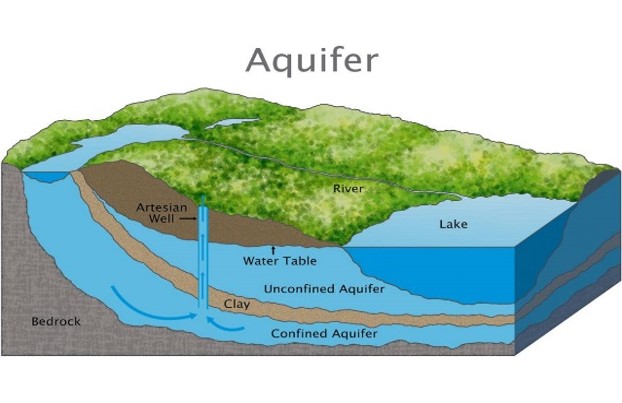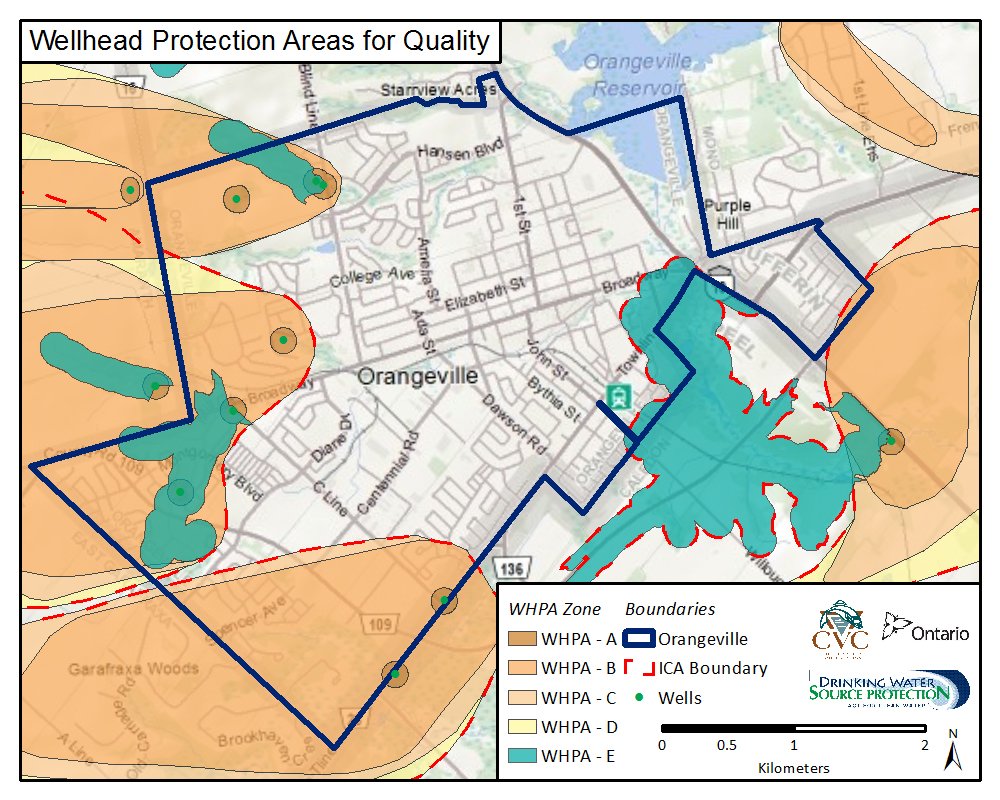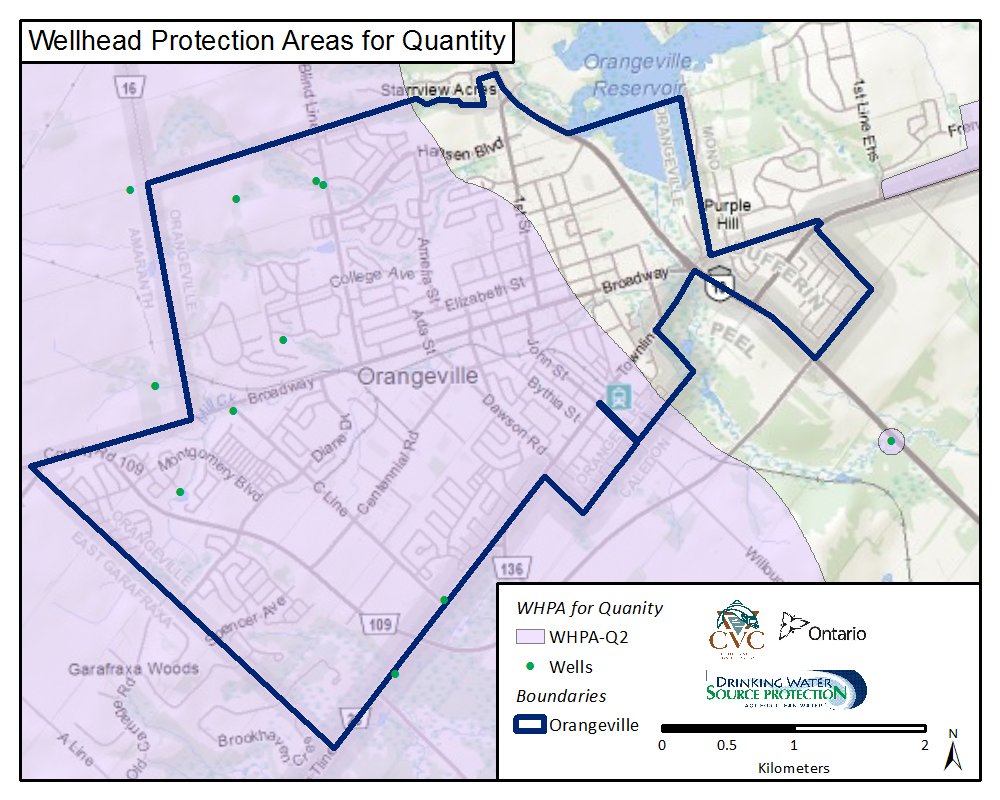|
Activities that are, or could be, significant threats to a municipal drinking water source are managed or removed by the source water protection plan.
Significant Threats pose the greatest risk to a municipal drinking water supply. Significant threats are:
1. Located in a vulnerable area, usually close to a well or intake.
2. Involve materials that have a high hazard rating.
A material's hazard rating depends on these factors:
- Toxicity: how dangerous it is to human health.
- Environmental fate: how quickly it moves through an aquifer and how quickly it may break down and become harmless.
- Quantity: how much is involved.
- Release to the environment: how easily it can get into the environment.
- Type of vulnerable area: where the activity is or would be located within a vulnerable area.
Chemical storage and handling
|
|
Many individuals and businesses use chemicals on a daily basis. It is important to ensure that chemicals are always handled, stored and disposed of responsibly so that they don't impact the drinking water supply in the Town of Orangeville.
Storing chemicals
You can prevent harmful chemical spills and leaks by practicing proper storage techniques:
- store chemicals in sealed containers with secure lids
- place containers on spill containment pallets
- designate a safe storage area
- ensure there is secondary containment around all containers to catch spills
You should also have a spill kit on site and train employees on how to safely clean a chemical spill.
Disposing of chemicals
If you use a hazardous chemical product, it is important that you dispose of the chemical safely so that it doesn't contaminate our drinking water. You should always use a local hazardous waste disposal site for safe disposal.
Make sure you don't dispose of hazardous liquids into:
- floor drains
- storm drains
- toilets
- sinks
- recycling or garbage bins
- municipal landfills
Finding alternatives
You can avoid or minimize the use of hazardous chemicals by choosing alternative products that are naturally occurring or water based. When selecting a product, you should:
- read the label and select products that don't have hazard warnings
- choose water-based detergent cleaners for the removal of dirt or grease on mechanical equipment or parts
- choose solvents that are not made from petroleum
- consider vinegar-based cleaners
- if an alternative can't be found, only use the necessary amount
Harmful chemicals and products
Dense Non-Aqueous Phase Liquids (DNAPLs) are a special class of chemicals that are particularly hazardous to our health and drinking water sources. These chemicals can sink into and contaminate ground water systems even with a minor spill.
Types of DNAPLs include:
- paints, stains and coatings
- paint removers or strippers
- wood treatment products
- spot removers and rug cleaners
- adhesives
- batteries
- printing inks
- cleaning and degreasing products
- pesticides
|
Fertilizer
|
|
Fertilizer provides nutrients for plant growth. However, when it is used in excess or applied incorrectly, it can harm the quality of our drinking water sources. Nitrogen (N) and phosphorus (P) are the two key components of fertilizer that can lead to pollution of local water resources.
Applying fertilizer
In order to limit the environmental impact of fertilizer, it is important that you apply fertilizer correctly. You should:
- only apply fertilizer in the spring to help with plant growth
- avoid applying before heavy rains or when the ground is frozen
- apply smaller amounts of fertilizer more frequently to avoid the build-up of excessive nutrients
- aerate the soil before applying fertilizer
- use quick release fertilizer on clay soil and slow release fertilizer on sandy soil
Reduce excess fertilizer
Take steps to reduce excess fertilizer use:
- take a soil test to find out the current nutrient levels in your soil
- choose a fertilizer that matches the nutrient requirements of your soil
- always apply fertilizer based on the recommended application rates
- leave grass clippings on your lawn after mowing to reduce the need for fertilizer
- plant native plant specifies because they require less fertilizer
Fertilizer handling and storage tips
Make sure to read and follow the manufacturer's instructions for proper handling and storage techniques. You should always:
- store fertilizer in a covered facility
- fill fertilizer spreaders on a hard surface
- sweep up any spills immediately
Check out Lake Superior Streams for more information about proper fertilizer use and storage.
|
Fuel storage and handling
|
|
Fuel and fuel storage systems contain hazardous chemicals which if released into the environment can threaten drinking water supplies. A fuel spill or leak that contaminates water supplies is a risk to our health and the health of our community.
Report fuel leaks and spills
If you own a fuel tank, you are responsible to for reporting all fuel leaks and spills to the Ontario Ministry of the Environment Spills Action Centre.
Storage tips
To protect our water source from potential fuel leaks, follow these fuel storage tips:
- place fuel tanks away from normal household and business activities
- if your tank is installed in garage or work yard, make sure there is distance and protection from vehicles
- install tanks away from drains and floor openings to prevent spills from escaping the property
- choose a double-walled or double-bottom tank
- install an overfill protection device on your fuel tank
- have drip trays installed under the tank and fuel line
- install a leak detection device
- empty and remove all unused fuel tanks and any potentially contaminated soil
Cleaning a spill
Make sure that you train your employees on how to prevent, contain and immediately clean-up fuel spills. You should also have a spill kit close to the tank for any potential spills.
|
Hazardous waste
|
|
Hazardous wastes are harmful to human health and a small spill or leak could contaminate water supplies. It's important to ensure we properly store and dispose of hazardous materials so that they do not make their way into the environment and negatively impact our land and water.
Disposing hazardous waste
Take action to safely dispose of hazardous waste:
- never dispose of hazardous wastes down a drain, toilet or in a garbage and recycling bin
- visit Dufferin County to find out about hazard waste disposal events
- hire a certified waste hauler to remove hazardous waste
Storing and handling hazardous waste
The best way to prevent contamination from hazardous waste is by using non-hazardous products. Consider switching products to something less harmful. If you are using hazardous products, please follow these storing and handling tips:
- have spill clean-up kit on site
- ensure all hazardous waste containers are in good condition
- clearly label all hazardous waste containers
- store waste containers indoors
- place containers on spill containments pallets or surfaces
Common hazardous waste products
Hazardous waste products are quite common in many household and businesses. Here are some common household hazardous waste products:
- automotive containers, fluids and batteries such as antifreeze, gasoline, motor oil, automotive batteries, fluids, etc.
- household chemicals and cleaning products such as aerosols, bleach, paints, pool chemicals, solvents etc.
- lawn and garden products such as fertilizer, pesticides and herbicides
- health and beauty products such as pharmaceuticals, expired medications, vitamins, sharps and syringes, nail polish, etc.
- electronics such as audio equipment, cameras, computers, phones, household appliances, televisions, radios etc.
- other household items such as compact fluorescent bulbs, batteries, lighters and lighter fluid, propane, thermostats containing mercury
Review the following businesses also produce hazardous waste materials:
- dry cleaning
- automotive repair
- chemical manufacturers
- construction
- laboratories
- printing
- equipment repair
- pesticide application
- furniture/wood manufacturing and refinishing
- electroplating
|
Urbanization and land development
|
|
The Town of Orangeville relies on groundwater for drinking water. As the Town becomes more urbanized, more precipitation is directed to storm sewers (run-off) and less rainfall is able to soak into the ground to recharge the groundwater system. This increase in run-off can reduce the available drinking water supply.
Low Impact Development strategies
Low Impact Development (LID), is a way to manage rainfall run-off by using landscaping and design strategies. These practices help improve water quality, reduce the risk of flooding and help recharge our groundwater.
|
Create a rain garden
|
|
Learn how to create a rain garden. Rain gardens look like a regular garden but are specifically designed to manage stormwater run-off. Use of sand-silt/loam soil mix to improve water absorption.
|
|
Redirect rooftop run-off
|
|
Position downspouts away from paved and hard surface areas. Instead, direct them towards your lawn or garden so the water can enter the ground faster.
|
|
Avoid asphalt and pavement
|
|
Asphalt and pavement prevent rain water from entering the ground. Instead, try using interlocker pavers, cobblestone, gravel or permeable asphalts and pavements on driveways and walkways on your property.
|
|
Try fusion landscaping
|
|
Fusion landscaping relies on low impact development techniques and nature based design to capture and use stormwater on site to water gardens. Learn more about fusion landscaping.
|
|
Septic systems
|
|
Septic systems are wastewater treatment units used by landowners who are not connected to the municipal wastewater system. When operated and maintained responsibly, septic systems are a safe and reliable way of treating household wastewater. However, if not properly maintained, septic systems could fail and contaminate nearby drinking water sources.
Septic system inspections
If your septic system is within 100 metres of a municipal drinking water well, your system will need to be inspected by Town staff every five years. We will contact property owners to book an inspection.
Maintaining your septic system
Here are a few things that you can do to protect your septic system and the environment:
- know the location of your septic system and leaching bed
- never dig, drive or build on your septic system because this can cause damage to the system
- keep accurate records of septic maintenance and service calls to ensure that you follow a proper cleaning schedule
- pump out your tank on a regular basis (every three to five years)
- divert surface water away from your leaching bed and make sure rain gutters don't drain in this area
- conserve water to reduce the amount of wastewater that needs to be treated
- avoid planting trees and shrubs close to the septic system because roots can cause damage
- insulate your pipes to protect water lines during the cold
- never put hazardous chemicals into your septic system
Signs your septic needs maintenance
Review the following signs to see if your septic needs some maintenance:
- spongy spots on or near the septic bed
- sewage on the ground or near the septic bed
- odour outside or in your basement
- slow or backed-up drains in your house
|
|



 (WHPA-Q1/Q2) represents the area where
(WHPA-Q1/Q2) represents the area where